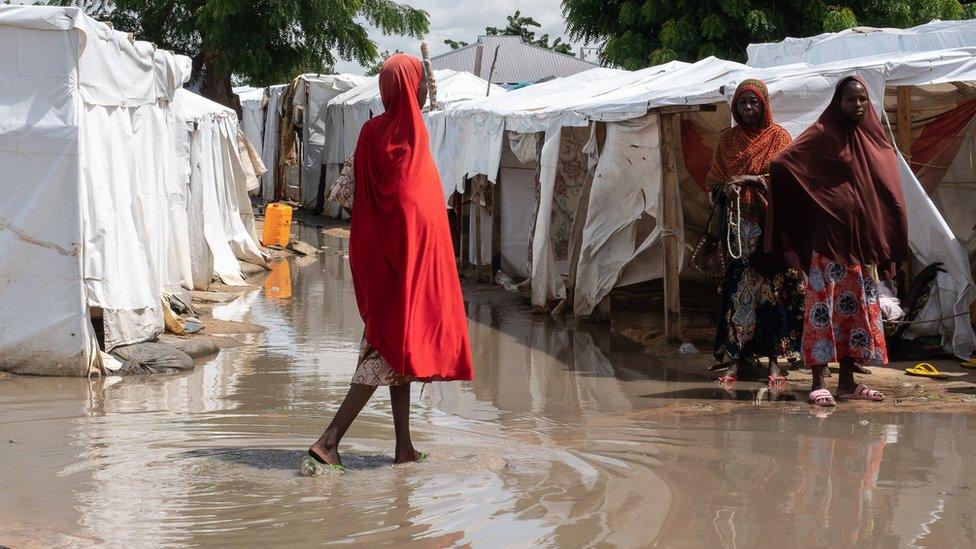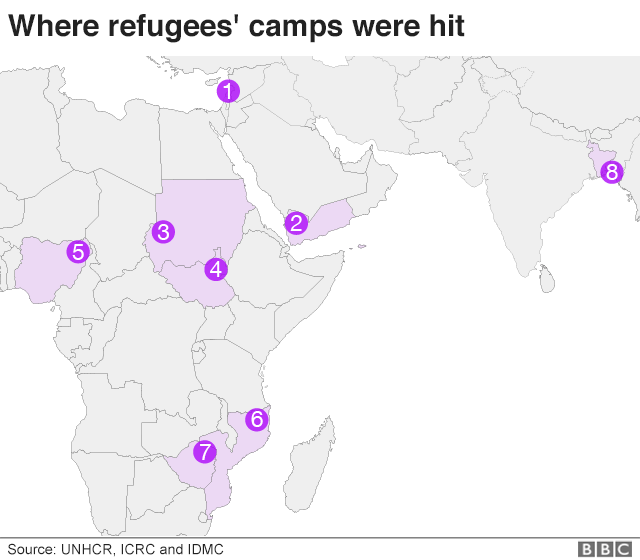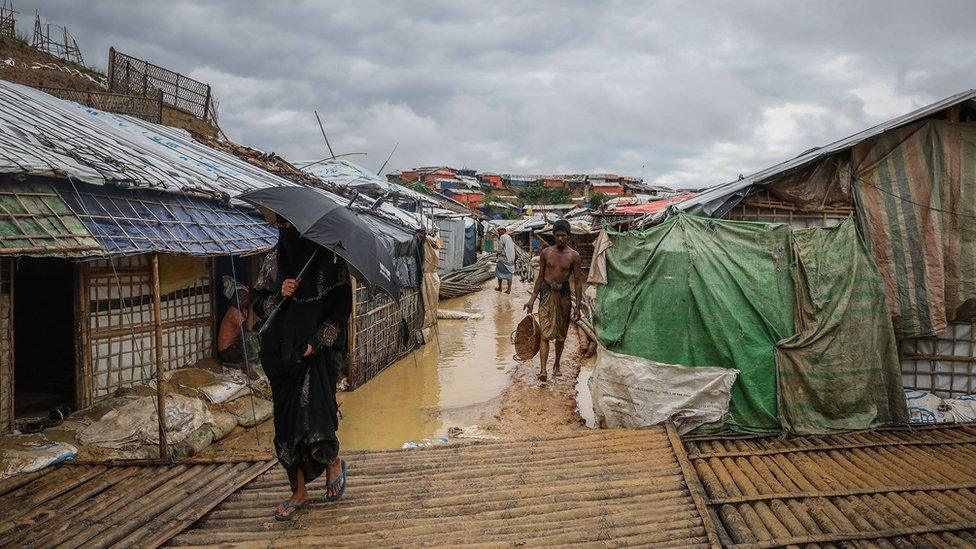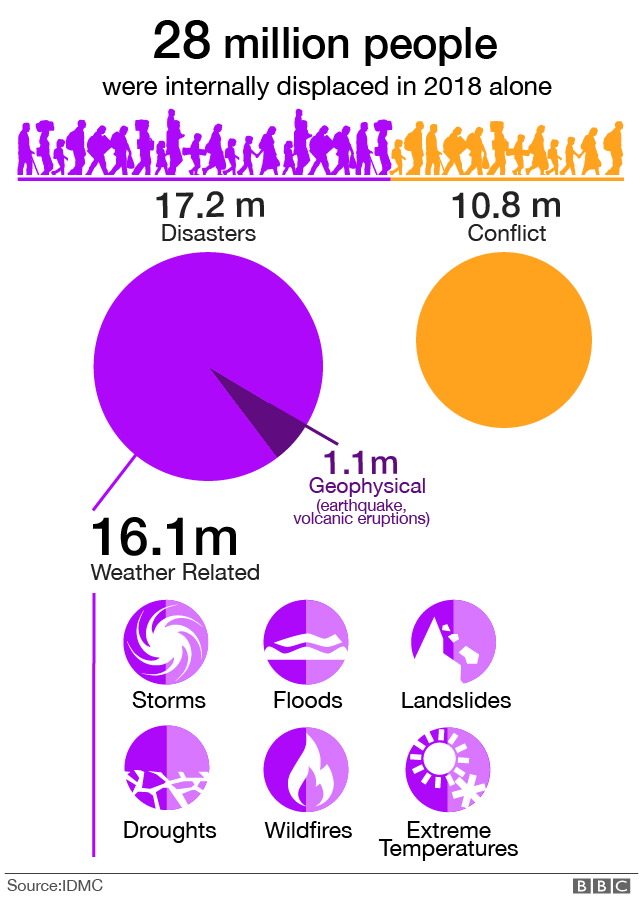Refugees at 'increased risk' from extreme weather
- Published

Temporary camps have been hit by extreme weather in recent years
Refugees and people displaced within countries because of conflict are increasingly vulnerable to the effects of extreme weather, experts say.
Humanitarian agencies told the BBC this posed significant challenges for their operations in different parts of the world.
Temporary camps for the displaced in Africa and Asia have been affected.
Extreme weather has even caused secondary displacements for populations that have already had to move.
Scientists say that extreme weather events will be the new normal if warming continues at its present rate.
But experts said climate change could not be linked directly to those weather-related disasters.
However, they argue, many of them concur with scientific predictions that the intensity and frequency of extreme weather will grow in a warming world.
"This has become our major challenge," Shabia Mantoo, a spokesperson with the UNHCR (United Nations refugee agency), told the BBC.
"An increasing number of camps for refugees and internally displaced people are being hit by extreme weather events and managing them in such conditions is proving to be increasingly difficult."



Double vulnerability
In most cases, flooding has been the major challenge.
When tropical cyclone Idai hit South East Africa, killing more than 1,000 people in March this year, a refugee camp in Zimbabwe was affected too, according to UNHCR officials.
They said many were injured in the Tongogara refugee camp that hosts some 13,000 refugees in Chipinge district.
"Around 2,000 refugee houses, mainly built using mud bricks, were completely or partially damaged," the UNHCR said at the time.
"Over 600 latrines have collapsed, and borehole water is feared to be contaminated due to flood waters. There is a real danger of an outbreak of waterborne diseases."

The UN refugee agency said it faced a similar situation in South Sudan, last October when a refugee camp in Maban county, with 15,000 displaced people from the country's neighbour Sudan, was hit by unprecedented flooding.
The area is prone to inundation during that time of the year because of seasonal rains. But that was not the only factor in that case.
"Flooding rivers in South Sudan come from the highlands in neighbouring Ethiopia, where rainfall is becoming more intense and irregular, and is also carving its way through neighbourhoods in broad, swift rivers," UNHCR spokesperson Andrej Mahecic said.
In Nigeria, temporary camps in Maiduguri sheltering people who fled Boko Haram insurgents from north-eastern parts of the country were also hit by floods following heavy rain in August this year, according to the Internal Displacement Monitoring Centre (IDCM).
The insurgency has displaced nearly 2.4 million people in the Lake Chad Basin, according to the UN figures.
"And many of this displaced population are being hit by one extreme weather event after another," said Mamadou Sow, head of the International Committee of the Red Cross (ICRC) in southern Africa.
"We call it double vulnerability and this is increasingly happening in our region."

In Asia, there is another example involving the Cox's Bazar camp in Bangladesh, where Rohingya refugees are sheltered.
During last year's monsoon, the camps there were not only flooded but some were also hit by landslides.
Officials with the International Migration Organisation (IOM) say the concentration of people in the camp, the way the land is used there and slope instability already made the site vulnerable.
"On top of that, the rains were so heavy they caused both floods and landslides," said Lorenzo Guadango of the IOM.
Climate scientists say monsoon rains in South Asia are becoming increasingly erratic.
In the Middle East, two heavy storms within a week that brought in rains, winds and snow hit informal settlements of Syrian refugees in Arsal, Lebanon, in January this year.
"Some people had their tents torn or broken. Other people had their tents flooded. Some people left... and moved to their relatives' tents. There is no doubt that the situation was very difficult,'' Hiba Fares, a UNHCR official on the ground explained.
On the move
It is not only refugees and displaced people already sheltered in camps who have been affected.

People in transit from one location to another are also hit by extreme weather
Humanitarian agencies cite the example of cyclone Kenneth that hit the northern part of Mozambique last April.
Officials with the ICRC said people who had fled the violence in Cabo Delgado province in the northern part of the country in 2017 were hit by the cyclone.
"Some of the people were on the move while others were temporarily settled in villages and they were hit by the cyclone," said Mr. Sow of the ICRC.
"Today there are 60,000 such displaced people who fled the violence in the northern part of the country and they all fear that they might be hit by extreme weather events."
A study by the UNHCR has also found that people already displaced for reasons other than natural disasters - including refugees, stateless people, and the internally displaced - often reside in climate change "hotspots" and may be exposed to secondary displacement.
Of the 28 million new internally displaced people across the world last year, 17.2 million had to move because of disasters. Some 90% of these was weather-related.

The UN puts the total figure of people forcibly displaced worldwide at more than 70 million.
The world body does not yet recognise people displaced by natural- and weather-related disasters as refugees.
No turning back
In some temporary camps, displaced people have been found to be unwilling to return even after the end of conflict and violence because their original homes are now affected by extreme weather.
"In the refugee camp of Sudan's Darfur, for instance, when the displaced people found that the region they came from is no more liveable because of acute drought conditions, they have refused to return," said Rofaida Elzubair with Practical Action, an international nongovernment organisation that has been helping communities in Sudan adapt to climate change.
"They don't want to go back even after the conflict has ended and as a result the UN has had to delay the closing down of the camp."